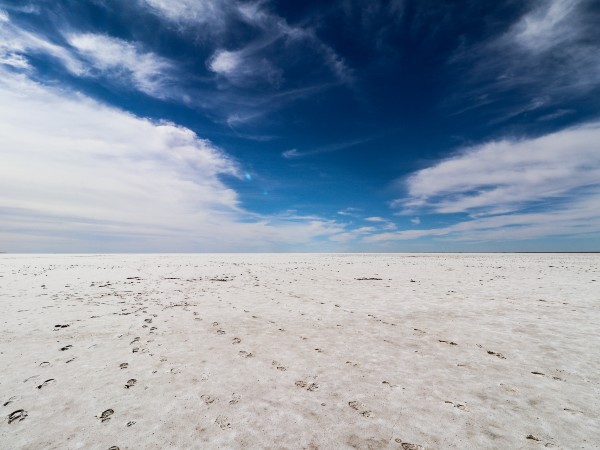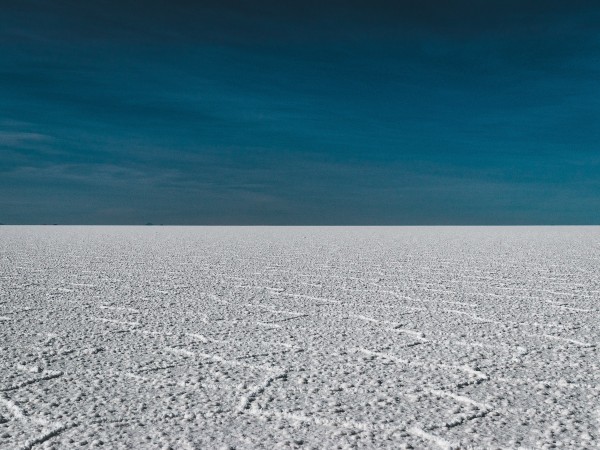Despite its name, Lake Eyre is barely a lake at all, but rather two huge, shallow scoops in the thirsty heartland of Australia. Its salt-caked floor is dry most of the time, and a rim of thick, encrusted minerals hangs like hoar frost around its shores. Coming upon the lake in 1858, the explorer Peter Warburton described the scene as 'terrible in its death-like stillness'.
The parched landscape stretched away on every side. To the north lie the shifting dunes of the Simpson Desert, to east and west are vast plains covered with dunes and gibbers - sharp stones that make walking difficult. To the south that makes walking difficult. To the south is a ribbon of salt lakes and dry saltpans. A glimpse of water is a tantalising prospect amid this desolation. All too often a watery vision on the horizon turns out to be a small, salty pool or a mirage created by temperatures up to 39C (102F). But once in a while, a traveller may come upon the welcome sight of a vast freshwater lake.

Lying at Australia's lowest point, with its bottom 50ft (15m) below sea level, Lake Eyre receives water from a region larger than France. Spain and Portugal put together. Its two parts, Lake Eyre North and the much smaller Lake Eyre South, together cover an area of about 3700sq miles (9600sq km). They are linked by the 9-mile (15km) long Godyer Channel. When it rains, water runs off the distant mountains and pours into the dry river courses. Much of the water evaporated or seeps into the sand, but if the rains have been heavy enough some may eventually reach Lake Eyre, 600 miles (1000km) downstream.
Only in years of very heavy flooding does water flow along the Goyder Channel. When the water reaches it, Lake Eyre explodes with teeming life. AS from nowhere, plants such as the vivid red sturt's desert pea spring up. They flower rapidly in the race to complete their life cycle and produce seeds before the moisture disappears. The water revives algae (minute revives algae (minute plants) and shrimp eggs lying dormant in the mud. Soon the lake is a seething soup of living creatures. It is not long before the birds arrive - ducks, avocets, cormorants, gulls - some having flown halfway across Australia. They feed on shrimps and fish swept in with the rivers. Along the lake shores, pelicans and banded stills set up noisy breeding colonies, sometimes numbering tens of thousands of nests.

When the water flow stops, the lake rapidly evaporated in the intense heat and gets increasingly salty. Timing is now critical. Nestlings must grow and learn to fly before the lake dries up, for as food and water become scarce the birds leave, and unfledged chicks are abandoned, The fresh-water fish have no means of escape, and suffocate in the salty water. The lake eventually reverts to a hard salt crust over damp mud, and the land is again an inhospitable wilderness, awaiting a new season of rains to bring it to life.
The hot sun can bake the mud into a solid clay pavement. It was on the hard flats of Madigan Gulf, on Lake Eyre North, that Donald Campbell broke the world land speed record of 403mph (644km/h) in bluebird, his turbine-driven car.
Speculation about lakes, or even a vast inland sea, in central Australia was popular among European pioneers. Many wondered where the rivers went that flowed towards the interior were. Most of the coast had been mapped by the 1830s, but much of the hinterland was known only to aborigines.

Edward Eyre set out from Adelaide in 1839 at the age of 25, intent on being the first European to cross the country from south to north. After crossing the Flinders Ranges he came up against a huge, impassable horseshoe of salt lakes, and was forced to turn back. In 1840 Eyre tried again, eventually reaching the lake that now bears his name. Although it was dry, the bears his name. Although it was dry, the treacherous mud floor prevented him from going farther.
Other explorers had similar experiences, yet reports of a great freshwater lake persisted. In 1922 Gerald Halligan surveyed Lake Eyre From the air and discovered water in the northern part. Yet when he visited the lake on foot the following year, he found barely enough water to float a boat.

Now it is clear that Lake Eyre can indeed be a vast expanse of fresh water - but only once in every eight or ten years. This cycle of events has been going on for some 20,000 years. Very occasionally heavy rains fall for two summers in succession. The first year's rain saturates the ground, so in the second year less is absorbed on the journey down from the mountains, and Lake Eyre is filled to its brim.



 Click it and Unblock the Notifications
Click it and Unblock the Notifications






















